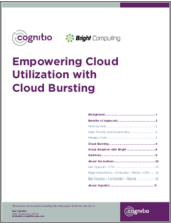Cloud computing has become a strong alternative to in house data centers for a large percentage of all enterprise needs. Most enterprises are adopting some form of could computing, with some estimates that as high as 90 % are putting workloads into a public cloud infrastructure. The whitepaper, Empowering Cloud Utilization with Cloud Bursting is an excellent summary of various options for enterprises that are planning for using a public cloud infrastructure.

Get this white paper on Cloud Bursting from the insideHPC White Paper Library
Both public and private cloud computing system can handle various demands. However, there are opportunities that many companies are looking at that involve some sort of combination of the two. Although a high percentage of organizations might be moving some workload to a public cloud, the amount of the total workload is a lot lower. Many organizations are trying to avoid risk of moving the entire workload to the cloud. However, this is a detriment to a long term strategy, as some applications will perform better in the cloud as well as save organizations on future OPEX and CAPEX costs.
Cloud bursting is a method that organizations can move some of their workloads to the cloud, when their in house data centers become overloaded, or at pre-determined criteria. For example, if a certain in-house infrastructure hits a certain level of CPU utilization or storage bandwidth, the next workloads can be assigned to run in a cloud environment. This might happen as a holiday season approaches or design deadlines must be met. By “bursting” the workloads to the cloud, organizations can extend their current environments, while allowing them to maintain control and the security of certain applications.
Orchestrating this movement of applications to the cloud involves a number of tools:
- Resource management
- Monitoring
- Configuration management
- Cloud interfacing
Put together, these tasks can be quite complicated and involve specialized knowledge. However, with the Bright Cluster Manager, these steps become much more manageable and can become part of an ongoing and everyday practice.
The whitepaper that describes how to simplify the transition to the cloud and create a Cluster-On-Demand and how to extend a cluster, or Cluster Extension. Be sure to evaluate your own requirements as you read this whitepaper, Empowering Cloud Utilization with Cloud Bursting.



